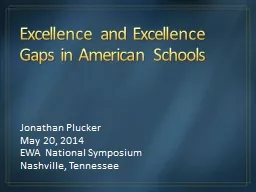

Jonathan Plucker May 20 2014 EWA National Symposium Nashville Tennessee The 21 st century The 21 st Century is clearly proving to be a brave new world where skills and talents that previously helped us achieve success need to be rethought ID: 495215
Download Presentation The PPT/PDF document "Excellence and Excellence Gaps in Americ..." is the property of its rightful owner. Permission is granted to download and print the materials on this web site for personal, non-commercial use only, and to display it on your personal computer provided you do not modify the materials and that you retain all copyright notices contained in the materials. By downloading content from our website, you accept the terms of this agreement.
Slide1
Excellence and Excellence Gaps in American Schools
Jonathan Plucker
May 20,
2014
EWA National Symposium
Nashville, TennesseeSlide2
The 21st centurySlide3
The 21st Century …
… is clearly proving to be a brave new world where skills and talents that previously helped us achieve success need to be rethought.Slide4Slide5
Who Gets U.S. Patents?Slide6
Excellence in the u.s.
and other countriesSlide7
Percent of Advanced Scores (625+) on TIMSS Math AssessmentsSlide8
Percent of Advanced Scores (625+) on TIMSS Science AssessmentsSlide9
Percent of Advanced Scores (625+) on TIMSS Grade 4 Reading AssessmentSlide10
Percent of Students Scoring Advanced on 2011 NAEP Grade 4 MathSlide11
Percent of Students Scoring Advanced on 2011 NAEP Grade 8 MathSlide12
Percent of Students Scoring Advanced on 2011 NAEP Grade 4 ReadingSlide13
Percent of Students Scoring Advanced on 2011 NAEP Grade 8 ReadingSlide14
Why Excellence Gaps? Slide15
Minimum Competency vs. Excellence Gaps by State
Blue: Minimum competency gap
Maroon: Excellence gapSlide16
Talent on theSidelines
Results
Slide17
NAEP % Advanced Reading Grade 4 - Race/EthnicitySlide18
NAEP % Advanced Reading Grade 8 - Race/EthnicitySlide19
NAEP % Advanced Math Grade 4 - Race/EthnicitySlide20
NAEP % Advanced Math Grade 8 - Race/Ethnicity
22.3Slide21
NAEP % Advanced Math Grade 4 - SESSlide22
NAEP % Advanced Math Grade 8 - SESSlide23
PovertySlide24
Poverty, Poverty, PovertySlide25
DeNavas
-Walt, Carmen, Bernadette D. Proctor, and Jessica C. Smith, U.S. Census Bureau, Current Population Reports, P60-239,
Income, Poverty, and Health Insurance Coverage in the United States: 2010
, U.S. Government Printing Office, Washington, DC,2011
.Slide26
Child Poverty Rates in Industrialized Countries
Source: UNICEF
Innocenti
Research Centre (2012), ‘Measuring Child
Poverty: New
league tables of child poverty in the world’s rich countries
’,
Innocenti
Report Card 10
, UNICEF
Innocenti
Research Centre, Florence.Slide27
Child Poverty Rates in Industrialized Countries
Source: UNICEF
Innocenti
Research Centre (2012), ‘Measuring Child
Poverty: New
league tables of child poverty in the world’s rich countries
’,
Innocenti
Report Card 10
, UNICEF
Innocenti
Research Centre, Florence.Slide28
State-by-State …
States with over 50% of students eligible for FRL: 17
States with over 40% of students eligible: 35
Range from 24% to 72%
States with majority-minority school populations: 13
States with near-majority-minority school populations: 10
Range from 8-92%
Source: NCES, Condition of Education, 2011 and 2012Slide29
Implications and InterventionsSlide30
Big Implication
We can predict with high accuracy that a talented student who is poor and/or Hispanic, Black, or Native American will not perform at advanced levels in K-12 education.
Hence “persistent talent underclass.”Slide31
Implications
As income disparity reaches unprecedented levels, we fear a vicious circle of EGs feeding greater income gaps, feeding greater EGs, feeding greater income gaps, etc.
The global warming of education?
i.e., people are resigned to this inequality
Andy
Smarick’s
recent thoughts about giftedness and the American consciousnessSlide32
Recommendations
Two questions
when covering education:
How will the proposed policy impact our highest achieving students
?
How
will the proposed policy help more students achieve at the highest levels?
Publish advanced test scores and excellence gaps whenever results are released.Slide33
Recommendations
Indicators for excellence and excellence gaps must be included in state accountability systems
21
st
century skills need to be incorporated into these systems
These are the skills other countries envy
Aggressively address low-hanging policy issues
Anti-acceleration policies, rigid kindergarten age cut-offsSlide34
Warren Buffett
Fortune, May 2, 2013:
No manager operates his or her plants at 80% efficiency when steps could be taken that would increase output. And no CEO wants male employees to be underutilized when improved training or working conditions would boost productivity. … If obvious benefits flow from helping the male component of the workforce achieve its potential, why in the world wouldn’t you want to include its counterpart? ... We've seen what can be accomplished when we use 50% of our human capacity. If you visualize what 100% can do, you'll join me as an unbridled optimist about America's future
.
Sure, but 50% is wildly optimistic.